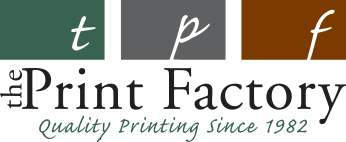
As you probably already know, there are several considerations at hand when it comes to printing. As the number one team of professional printers in NH, The Print Factory is taking this time to look at a few of those.
From understanding the differences between RGB and CYMK to the basics of design, many details requiring knowledge and precision. Today, the experts at The Print Factory are taking a closer look at yet another one of these details – the paper choice. Weight to coating, the options can be overwhelming when starting. So, how do you know what to choose and which combination of properties is best to obtain the desired results? Let’s take a look.
Paper Weight
First, let’s start by discussing paper weight. Unlike the traditional associations with the word ‘weight,’ paper weight refers to the thickness of the paper. The higher the number, the thicker the paper will be. Why does paper thickness matter? Well, when it concerns printing, ink reacts differently to a thicker piece of paper than a thinner one. As a general rule of thumb, the heavier the paper is, the thicker the paper will be.
Weight is measured in pounds per 500 sheets.
When figuring this out, it’s important to keep in mind the terms ‘text’ and ‘cover.’ Text paper, or text stock, is the thinner of the two options. It is thin paper that you would find in a textbook or novel – easy comparison. On the other hand, cover, or stock paper, offers a thicker, more sturdy option. Of course, there are several other options, but these two provide a solid starting point.
- Light: Text 60-80lb.
Regular textbook or novel pages
- Medium: Cover 65-80 lb.
Accepted in most home printers, greeting cards
- Heavy: Cover 80-100lb.
Generally will jam a home printer. Must be scored before folding.
- Extra-Heavy: Cover 110lb+
Gift box thickness or greater. Commercial printer required
Paper Coatings
Like paper weight, there are also several coating options. Choosing the right coating for your project depends on the desired outcome, look and feel you hope to achieve. Two of the most common options are matte and glossy. These options are on the opposite ends of the spectrum but give you an idea of what is meant by ‘coating.’
- Glossy – This option is the shiniest coating available with the most reflective properties. While glossy paper offers the highest clarity, how it is displayed becomes a consideration.
- Satin – Also referred to as semi-glass, satin offers full color printing for high resolution details. With a less reflective surface than glossy paper, this option is sometimes the better choice when printing images viewed behind glass.
- Silk – In the middle of glass and matte, silk has slightly reflective properties with a soft to the touch feel. This option provides a nice quality result with the ability to effectively handwrite on the paper as well.
- Matte – With no sheen or reflective properties, matte paper has an extremely low reflective property. Although high resolution printing is an option, obtaining precise details becomes a much harder task. Matte paper is best for text-only documents.
- Dull – Rarely used, a dull coating provides no visible shine.
And then, of course, you also have the option of uncoated paper. With no surface coating, ink is fully absorbed into the paper. Often, an uncoated paper produces results that dull and blur images. However, this option provides a more natural look. So, again, choosing the right paper finish depends upon the desired result.
When choosing the perfect paper for your project, the professional NH printers at The Print Factory are here to help! Give us a call today for more information on taking your print project to the next level (603) 880-4519.
